2018 RENAULT SCENIC belt
[x] Cancel search: beltPage 160 of 364
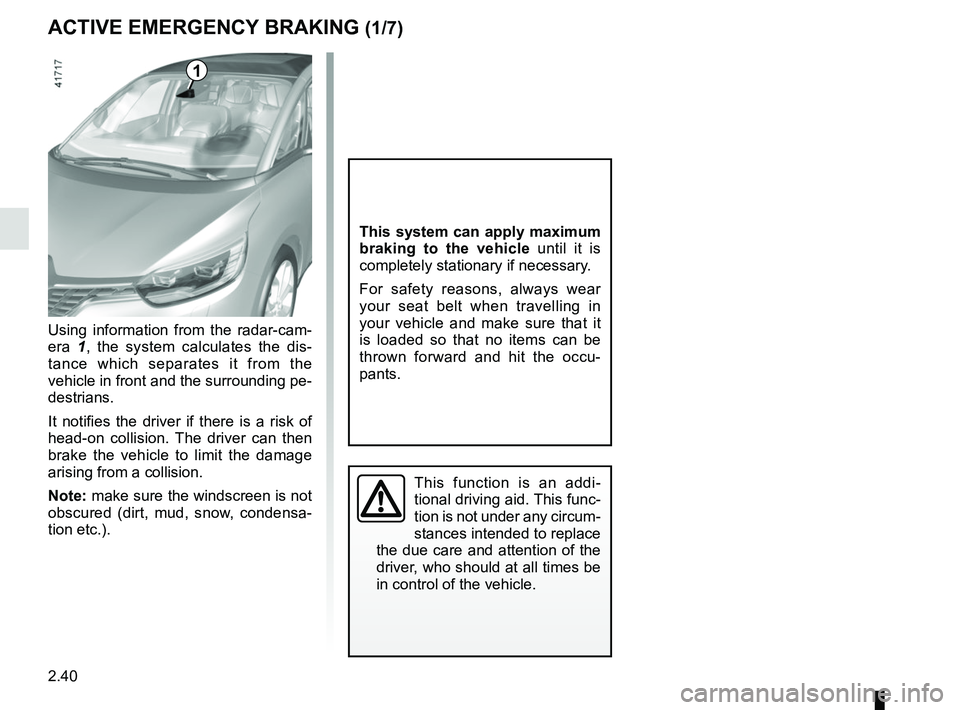
2.40
ACTIVE EMERGENCY BRAKING (1/7)
Using information from the radar-cam-
era 1, the system calculates the dis-
tance which separates it from the
vehicle in front and the surrounding pe-
destrians.
It notifies the driver if there is a risk of
head-on collision. The driver can then
brake the vehicle to limit the damage
arising from a collision.
Note: make sure the windscreen is not
obscured (dirt, mud, snow, condensa-
tion etc.).
1
This function is an addi-
tional driving aid. This func-
tion is not under any circum-
stances intended to replace
the due care and attention of the
driver, who should at all times be
in control of the vehicle.
This system can apply maximum
braking to the vehicle until it is
completely stationary if necessary.
For safety reasons, always wear
your seat belt when travelling in
your vehicle and make sure that it
is loaded so that no items can be
thrown forward and hit the occu-
pants.
Page 256 of 364
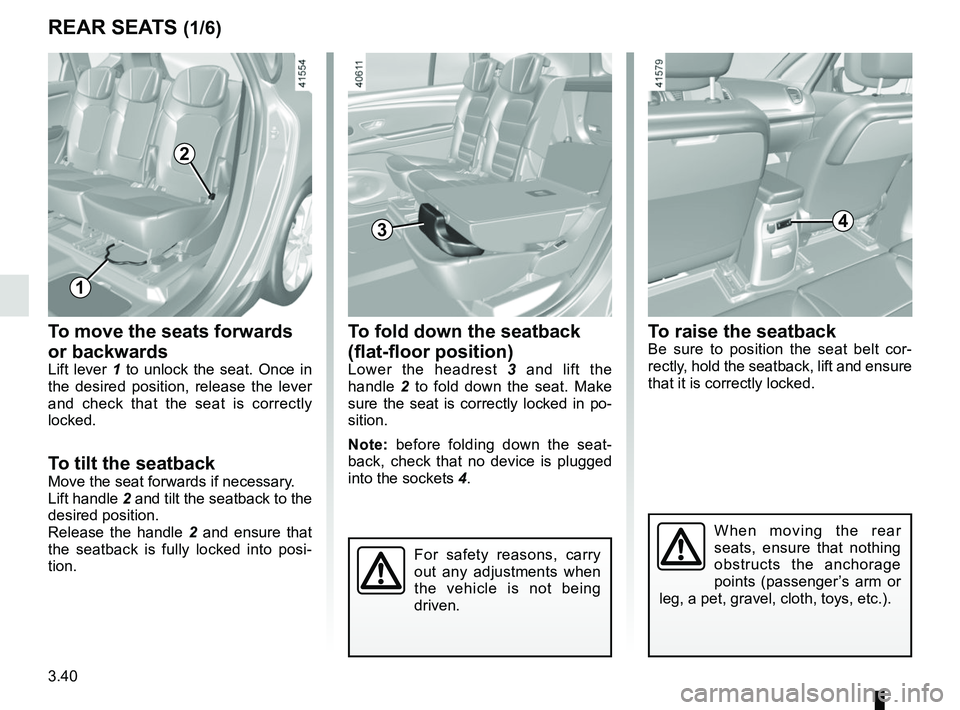
3.40
To move the seats forwards
or backwards
Lift lever 1 to unlock the seat. Once in
the desired position, release the lever
and check that the seat is correctly
locked.
To tilt the seatbackMove the seat forwards if necessary.
Lift handle 2 and tilt the seatback to the
desired position.
Release the handle 2 and ensure that
the seatback is fully locked into posi-
tion.
REAR SEATS (1/6)
2
When moving the rear
seats, ensure that nothing
obstructs the anchorage
points (passenger’s arm or
leg, a pet, gravel, cloth, toys, etc.).
3
To fold down the seatback
(flat-floor position)
Lower the headrest 3 and lift the
handle 2 to fold down the seat. Make
sure the seat is correctly locked in po-
sition.
Note: before folding down the seat-
back, check that no device is plugged
into the sockets 4.
1
For safety reasons, carry
out any adjustments when
the vehicle is not being
driven.
To raise the seatbackBe sure to position the seat belt cor-
rectly, hold the seatback, lift and ensure
that it is correctly locked.
4
Page 257 of 364
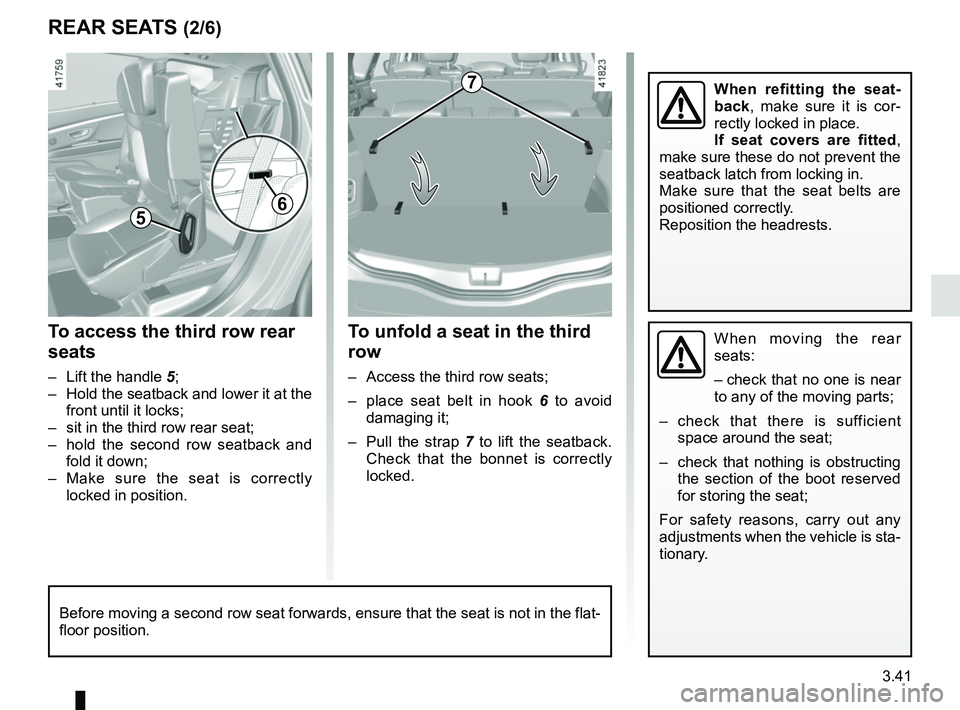
3.41
REAR SEATS (2/6)
To unfold a seat in the third
row
– Access the third row seats;
– place seat belt in hook 6 to avoid
damaging it;
– Pull the strap 7 to lift the seatback.
Check that the bonnet is correctly
locked.
To access the third row rear
seats
– Lift the handle 5;
– Hold the seatback and lower it at the front until it locks;
– sit in the third row rear seat;
– hold the second row seatback and fold it down;
– Make sure the seat is correctly locked in position.
56
When moving the rear
seats:
– check that no one is near
to any of the moving parts;
– check that there is sufficient space around the seat;
– check that nothing is obstructing the section of the boot reserved
for storing the seat;
For safety reasons, carry out any
adjustments when the vehicle is sta-
tionary.
Before moving a second row seat forwards, ensure that the seat is not in\
the flat-
floor position.
7When refitting the seat-
back, make sure it is cor-
rectly locked in place.
If seat covers are fitted ,
make sure these do not prevent the
seatback latch from locking in.
Make sure that the seat belts are
positioned correctly.
Reposition the headrests.
Page 259 of 364

3.43
REAR SEATS (4/6)
To automatically fold down
the seats (flat position)
The rear seats are electrically unlocked
to fold down in order to create a flat
floor.
There are two ways to manoeuvre the
seats:
– from the boot using control 12;
– on the multifunction screen 13. Disabling the function
– With the engine running, a buckled
seat belt prevents the movement of
the relevant seat.
– Once the vehicle is moving the two controls are deactivated.
To raise the seats manually
Raise each seat as described on the
previous pages.
13
Conditions of use
With the vehicle at a standstill and the
rear seat belts unlocked:
– from control 12, with the boot lid
open;
– from the multifunction screen 13, with the engine running.
Note: Before performing any unlock-
ing operations to fold down the seats,
the trays on the back of the front seats
must be folded away.
12
When moving the rear
seats:
– check that no one is near
to any of the moving parts;
– check that there is sufficient space around the seat;
– check that nothing is obstructing the section of the boot reserved
for storing the seat;
For safety reasons, carry out any
adjustments when the vehicle is sta-
tionary.
Page 267 of 364
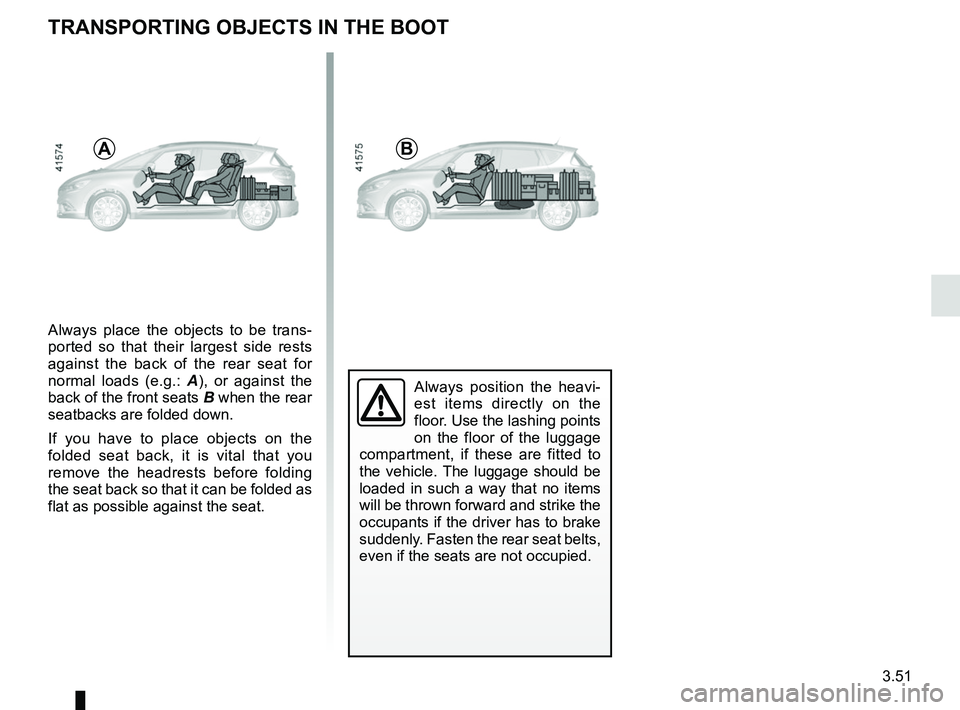
3.51
Always place the objects to be trans-
ported so that their largest side rests
against the back of the rear seat for
normal loads (e.g.: A), or against the
back of the front seats B when the rear
seatbacks are folded down.
If you have to place objects on the
folded seat back, it is vital that you
remove the headrests before folding
the seat back so that it can be folded as
flat as possible against the seat.
TRANSPORTING OBJECTS IN THE BOOT
A
Always position the heavi-
est items directly on the
floor. Use the lashing points
on the floor of the luggage
compartment, if these are fitted to
the vehicle. The luggage should be
loaded in such a way that no items
will be thrown forward and strike the
occupants if the driver has to brake
suddenly. Fasten the rear seat belts,
even if the seats are not occupied.
B
Page 290 of 364
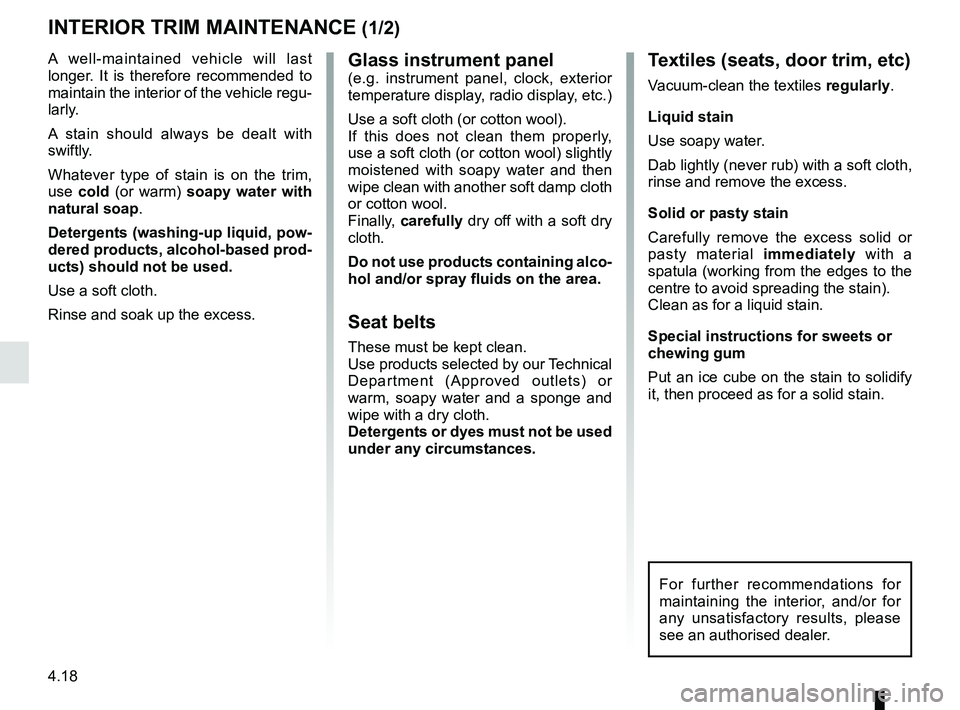
4.18
Glass instrument panel(e.g. instrument panel, clock, exterior
temperature display, radio display, etc.)
Use a soft cloth (or cotton wool).
If this does not clean them properly,
use a soft cloth (or cotton wool) slightly
moistened with soapy water and then
wipe clean with another soft damp cloth
or cotton wool.
Finally, carefully dry off with a soft dry
cloth.
Do not use products containing alco-
hol and/or spray fluids on the area.
Seat belts
These must be kept clean.
Use products selected by our Technical
Department (Approved outlets) or
warm, soapy water and a sponge and
wipe with a dry cloth.
Detergents or dyes must not be used
under any circumstances.
INTERIOR TRIM MAINTENANCE (1/2)
Textiles (seats, door trim, etc)
Vacuum-clean the textiles regularly.
Liquid stain
Use soapy water.
Dab lightly (never rub) with a soft cloth,
rinse and remove the excess.
Solid or pasty stain
Carefully remove the excess solid or
pasty material immediately with a
spatula (working from the edges to the
centre to avoid spreading the stain).
Clean as for a liquid stain.
Special instructions for sweets or
chewing gum
Put an ice cube on the stain to solidify
it, then proceed as for a solid stain.
A well-maintained vehicle will last
longer. It is therefore recommended to
maintain the interior of the vehicle regu-
larly.
A stain should always be dealt with
swiftly.
Whatever type of stain is on the trim,
use
cold (or warm) soapy water with
natural soap.
Detergents (washing-up liquid, pow-
dered products, alcohol-based prod-
ucts) should not be used.
Use a soft cloth.
Rinse and soak up the excess.
For further recommendations for
maintaining the interior, and/or for
any unsatisfactory results, please
see an authorised dealer.
Page 336 of 364

5.44
OPERATING FAULTS (7/7)
Electrical equipmentPOSSIBLE CAUSESWHAT TO DO
Traces of condensation in the head-
lights or rear lights. Traces of condensation may be a nat-
ural phenomenon caused by varia-
tions in temperature and humidity.
In this case, the traces will disappear
slowly once the lights are switched
on.
The front seat belt reminder light
comes on when the seat belts are
fastened. An object is stuck between the floor
and the seat and is disrupting the op-
eration of the sensor. Remove all objects from underneath the
front seats.
Page 357 of 364

7.1
ALPHABETICAL INDEX (1/6)
A
ABS ....................................................................\
...2.35 → 2.39
accessories........................................................................\
5.33
accessories socket ................................................... 3.23, 3.38
adaptive cruise control...........................................2.74 → 2.81
additional methods of restraint .....................1.32 → 1.35, 1.38
side protection ............................................................. 1.37
to the rear seat belts ........................................1.32 → 1.36
adjusting your driving position ........................................... 1.28
advice on antipollution ....................................................... 2.30
air bag....................................................................1.32 → 1.38
activating the front passenger air bags ........................ 1.61
deactivating the front passenger air bags .................... 1.59
air conditioning ....................................3.6 → 3.13, 3.19 – 3.20
A
air vent (Hybrid Assist).............................................. 3.45, 3.50
A
air vents ...................................................................... 3.4 – 3.5
anti-corrosion check ..............................................6.15 → 6.20
anti-corrosion protection .................................................... 4.15
anti-lock braking system: ABS ...............................2.35 → 2.39
antipollution advice .................................................................\
......... 2.30
armrest: front ..................................................................\
............ 3.33
ashtray ................................................................\
............... 3.38
assisted parking............................... 2.82 → 2.86, 2.89 → 2.92
automatic gearbox (use) ........................................2.93 → 2.95
automatic gearbox selector lever...........................2.93 → 2.95
B
battery..................................................................... 4.11 – 4.12 troubleshooting ................................................. 5.29 – 5.30
battery (remote control) ..................................................... 5.32 blind spot warning signal .......................................2.55
→ 2.58
blind spot: warning signal ......................................2.55 → 2.58
bonnet........................................................................\
. 4.2 – 4.3
brake fluid ........................................................................\
.... 4.9
bulbs changing ..........................................................5.17 → 5.23
C
catalytic converter................................................... 2.12 – 2.13
central door locking ...............1.2 – 1.3, 1.5, 1.12 → 1.15, 1.18
changing a bulb .....................................................5.17 → 5.23
changing a wheel.................................................... 5.12 – 5.13
changing gear ...............................................2.20, 2.93 → 2.95
child restraint/seat .............................1.39 – 1.40, 1.42 → 1.58
child safety.........................1.6, 1.39 – 1.40, 1.42 → 1.58, 3.24
child seats..........................................1.39 – 1.40, 1.42 → 1.58
children .......................................................... 1.39 – 1.40, 1.40
children (safety) .......................................................... 1.6, 3.24
cigar lighter ........................................................................\
3.38
cleaning: inside the vehicle .............................................. 4.18 – 4.19
clock ..................................................................\
................ 1.90
closing the doors ...................................................1.13 → 1.17
control instruments ................................................. 1.78 – 1.79
controls ...............................................................\
...1.62 → 1.65
coolant ................................................................\
................. 4.8
courtesy light .....................................3.27 – 3.28, 5.24 → 5.26
courtesy mirrors ................................................................. 3.29
cruise control .........................................................2.67 → 2.73
cruise control-speed limiter....................................2.67 → 2.73
customised vehicle settings ................................... 1.88 – 1.89
customising the vehicle settings ............................ 1.88 – 1.89
D
dashboard..............................................................1.62 → 1.65
daytime running lights........................................................ 1.98